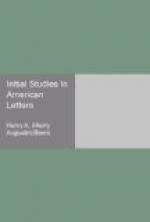The period between the close of the second war with England, in 1815, and the great financial crash of 1837, has been called, in language attributed to President Monroe, “the era of good feeling.” It was a time of peace and prosperity, of rapid growth in population and rapid extension of territory. The new nation was entering upon its vast estates and beginning to realize its manifest destiny. The peace with Great Britain, by calling off the Canadian Indians and the other tribes in alliance with England, had opened up the North-west to settlement. Ohio had been admitted as a State in 1802; but at the time of President Monroe’s tour, in 1817, Cincinnati had only seven thousand inhabitants, and half of the State was unsettled. The Ohio River flowed for most of its course through an unbroken wilderness. Chicago was merely a fort. Hitherto the emigration to the West had been sporadic; now it took on the dimensions of a general and almost a concerted exodus. This movement was stimulated in New England by the cold summer of 1816 and the late spring of 1817, which produced a scarcity of food that amounted in parts of the interior to a veritable famine. All through this period sounded the ax of the pioneer clearing the forest about his log-cabin, and the rumble of the canvas-covered emigrant-wagon over the primitive highways which crossed the Alleghanies or followed the valley of the Mohawk. S. G. Goodrich, known in letters as “Peter Parley,” in his Recollections of a Life-time, 1856, describes the part of the movement which he had witnessed as a boy in Fairfield County, Connecticut: “I remember very well the tide of emigration through Connecticut, on its way to the West, during the summer of 1817. Some persons went in covered wagons—frequently a family consisting of father, mother, and nine small children, with one at the breast—some on foot, and some crowded together under the cover, with kettles, gridirons, feather-beds, crockery, and the family Bible, Watts’s Psalms and Hymns, and Webster’s Spelling-book—the lares and penates of the household. Others started in ox-carts, and trudged on at the rate of ten miles a day. . . . Many of these persons were in a state of poverty, and begged their way as they went. Some died before they reached the expected Canaan; many perished after their arrival from fatigue and privation; and others from the fever and ague, which was then certain to attack the new settlers. It was, I think, in 1818 that I published a small tract entitled, ’Tother Side of Ohio—that is, the other view, in contrast to the popular notion that it was the paradise of the world. It was written by Dr. Hand—a talented young physician of Berlin—who had made a visit to the West about these days. It consisted mainly of vivid but painful pictures of the accidents and incidents attending this wholesale migration. The roads over the Alleghanies, between Philadelphia and Pittsburg, were then rude, steep, and dangerous, and some of the more precipitous slopes were consequently strewn with the carcasses of wagons, carts, horses, oxen, which had made shipwreck in their perilous descents.”




